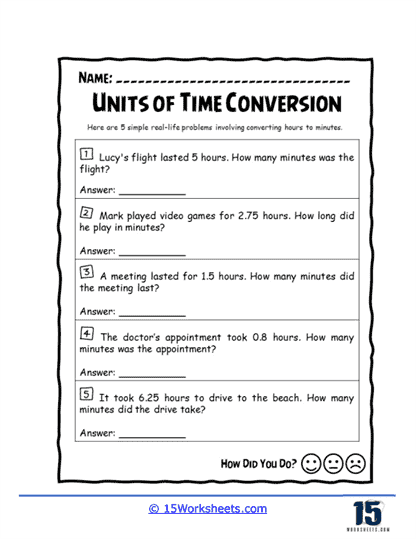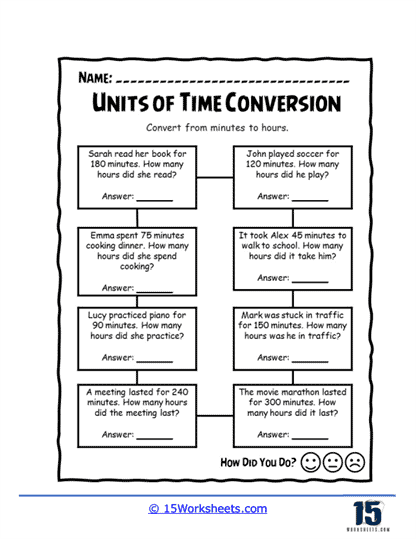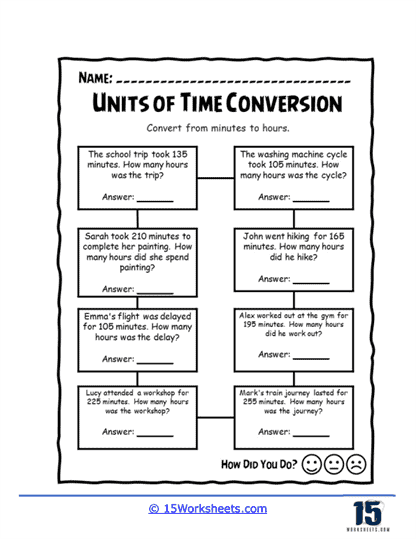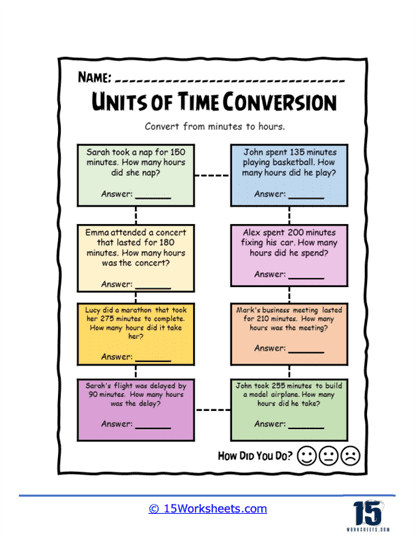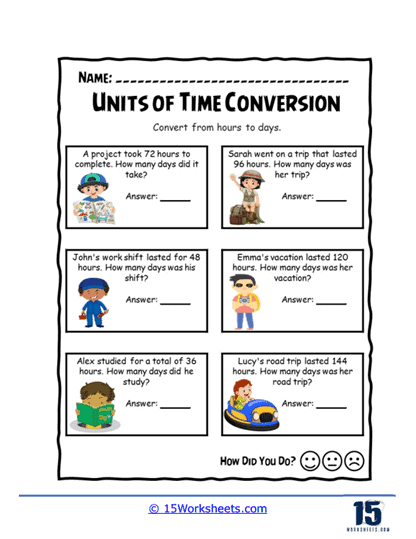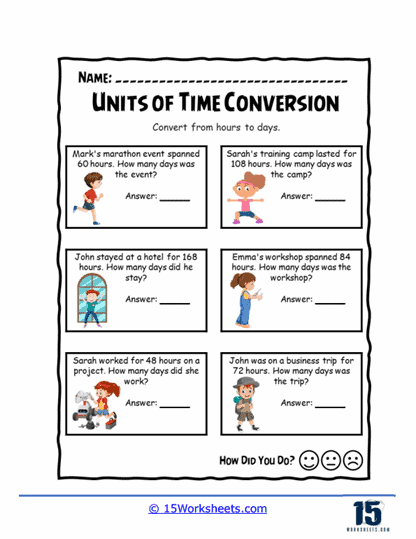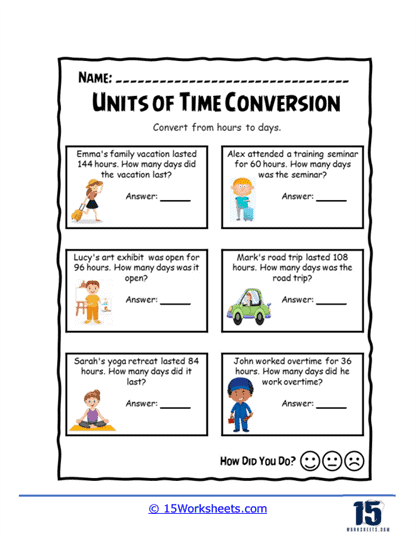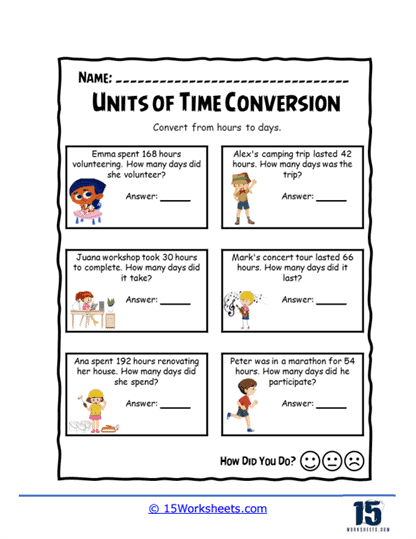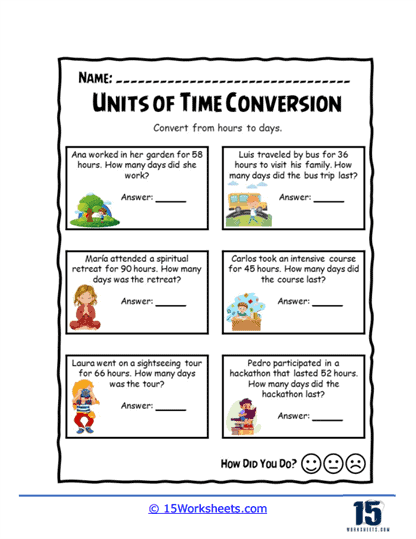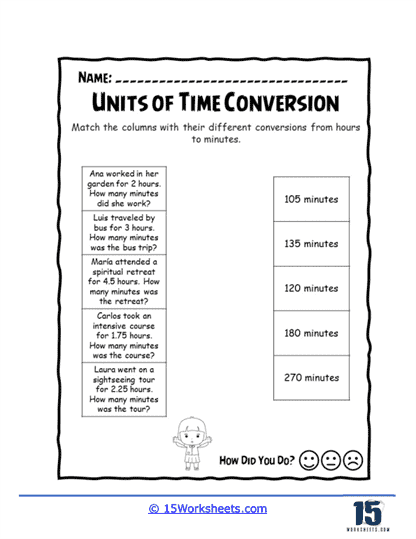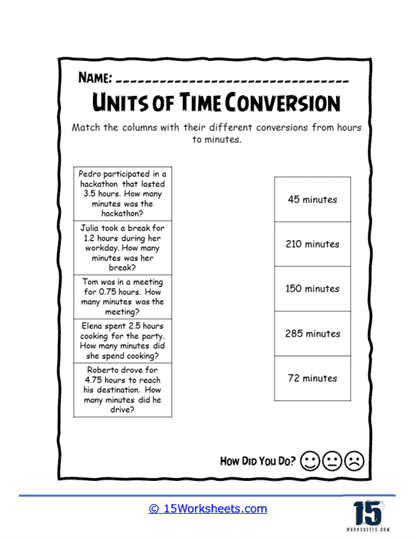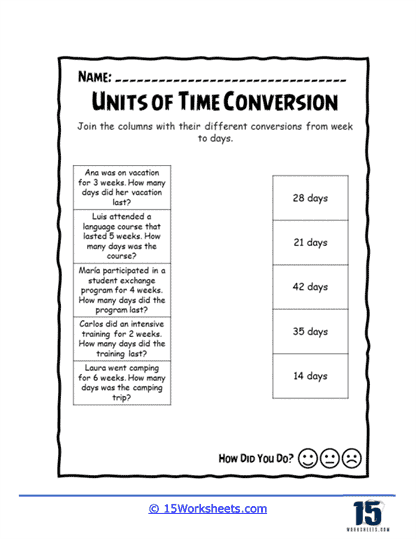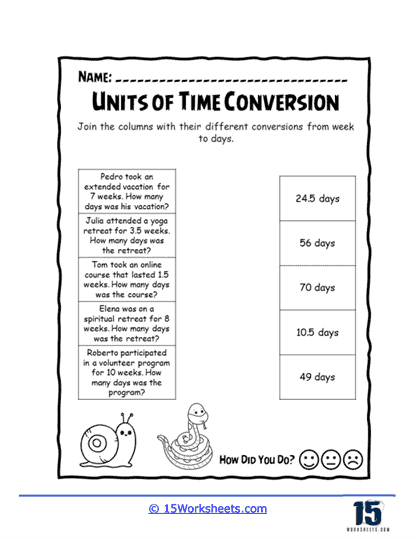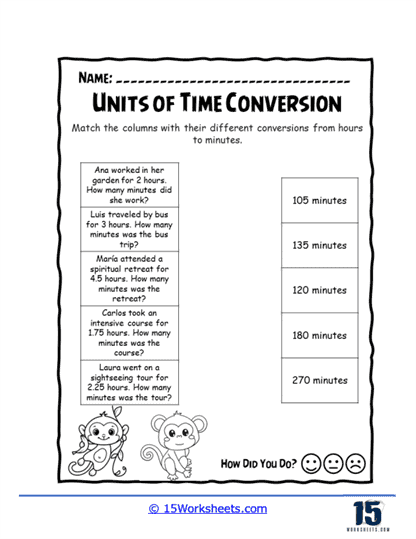Units of Time Conversion Worksheets
About These 15 Worksheets
These worksheets will help students learn how to convert between different units of time, such as hours to minutes, minutes to hours, weeks to days, and days to weeks. These worksheets present a variety of exercises that require students to understand and apply the relationships between different time units. This foundational skill is crucial for both academic success and everyday life, as time management and scheduling are essential components of daily activities.
These worksheets typically include a range of scenarios and practical examples that make learning engaging and relevant. They may feature fun themes and illustrations to capture the interest of young learners, ensuring that the process of mastering time conversions remains enjoyable and stimulating.
Types of Problems
These worksheets help students understand and perform conversions between different units of time. These worksheets typically cover a range of exercises that teach students how to convert between seconds, minutes, hours, days, weeks, months, and years. The problems vary in complexity, ensuring a comprehensive grasp of time units and their interrelationships.
One common type of problem on these worksheets involves straightforward conversions where students are asked to convert one unit of time to another. For example, a worksheet might provide a series of problems such as converting 120 seconds to minutes, 3 hours to minutes, or 5 days to hours. These exercises help students understand the basic equivalences between units of time (e.g., 60 seconds in a minute, 60 minutes in an hour, 24 hours in a day) and reinforce their multiplication and division skills.
Another type of exercise involves more complex, multi-step conversions. For instance, students might be asked to convert a larger unit of time to a smaller unit in multiple stages, such as converting 2 days into seconds. This type of problem requires students to break down the conversion into smaller steps (days to hours, hours to minutes, and then minutes to seconds) and apply multiple operations, enhancing their problem-solving and critical-thinking skills.
Worksheets include word problems that place time conversions within real-life contexts. For example, a problem might describe a scenario such as, “A movie lasts for 2 hours and 30 minutes. How many minutes is this in total?” These problems help students see the practical application of time conversions and improve their ability to interpret and solve problems that involve time in everyday situations. Word problems can also include scenarios like calculating the total duration of events, such as the combined length of several activities measured in different units.
Some worksheets present conversion tables or charts that students use to solve problems. For example, students might be given a table that shows the relationships between different units of time and then be asked to fill in missing values or use the table to answer questions. These exercises help students become familiar with reference tools and improve their ability to use such resources to solve problems efficiently.
Another common exercise type involves comparing time units. For instance, students might be asked to determine which of two given times is longer or shorter, such as comparing 180 minutes to 3 hours or 1 week to 7 days. These comparison problems help students understand the relative sizes of different time units and reinforce their ability to perform mental calculations and quick conversions.
The Benefits Of These Worksheets
Learning how to convert between units of time provides several educational and practical benefits that extend into various aspects of daily life and professional activities. One of the primary benefits is the enhancement of mathematical proficiency. Converting between units of time requires a solid understanding of multiplication and division, as well as the ability to recognize and apply numerical relationships. This process reinforces basic arithmetic skills, sharpens problem-solving abilities, and helps students develop a more intuitive understanding of quantities and their conversions.
Another significant benefit is the development of critical thinking and analytical skills. Time conversion problems often require students to break down complex tasks into smaller, manageable steps. For example, converting days into seconds involves understanding the intermediary steps of converting days to hours, hours to minutes, and then minutes to seconds. This multi-step process enhances students’ ability to think logically and sequentially, fostering a systematic approach to solving problems.
Learning time conversions promotes a deeper understanding of the concept of time and its various units. It helps students appreciate how different units of time relate to each other and how they are used in everyday contexts. This understanding is crucial for developing effective time management skills, as it enables individuals to plan and allocate their time more efficiently. By mastering time conversions, students are better equipped to organize their schedules, set realistic deadlines, and manage their activities.
Real World Application Of This Skill
In the real world, the ability to convert between units of time is indispensable across numerous scenarios. In educational settings, students use this skill to understand and manage their class schedules, homework deadlines, and study periods. For instance, knowing how to convert hours to minutes helps students allocate sufficient time for each subject during study sessions. Teachers also rely on these skills to plan lessons, allocate time for different activities, and ensure that the school day runs smoothly.
In professional contexts, time conversion skills are crucial for productivity and efficiency. Many jobs require precise time management and scheduling. For example, project managers often need to estimate project durations, convert these estimates into different units for reporting, and manage timelines to ensure deadlines are met. In the healthcare industry, professionals must accurately convert units of time to administer medications at the correct intervals, schedule patient appointments, and track the duration of medical procedures.
In fields such as transportation and logistics, time conversion is essential for coordinating schedules and optimizing operations. Flight schedules, train timetables, and delivery routes often require converting between different units of time to ensure punctuality and efficiency. For instance, a logistics manager might need to convert travel time from hours to minutes to synchronize multiple deliveries accurately.
Example Problem – Anna read her book for 3 hours. How many minutes did she spend reading?
Step-by-Step Solution
1. Identify the given time
The given time is 3 hours.
2. Understand the conversion factor
There are 60 minutes in one hour.
3. Perform the conversion
Multiply the number of hours by the number of minutes in an hour.
3 hours x 60 minutes per hour = 180 minutes
4. Write the answer
Anna spent 180 minutes reading.


